ChessBase.com - Chess News - Sinequefields Purchase Bobby Fischer's Chess Collection
Sinequefields Purchase Bobby Fischer's Chess Collection
St. Louis, June 11 – Rex and Jeanne Sinquefield have purchased the chess library of the legendary Bobby Fischer, including notebooks he prepared for his 1972 World Championship match with Boris Spassky. The Sinquefields acquired the collection through San Francisco-based auction house, Bonhams and Butterfields.
"I am thrilled to have this collection from arguably the greatest chess player in history," said Rex Sinquefield, founder and board president of the Chess Club and Scholastic Center of Saint Louis. "I have been a lifelong fan of Bobby Fischer."
Tuesday, June 30, 2009
Monday, June 29, 2009
Chess is 99 percent tactics. - Teichmann

Here are several tactital themes from 303 Tricky Chess Tactics by Fred Wilson and Bruce Albertson.
I am leaving it up to my chess blog readers to find the solutions or better yet I recommend purchasing the book on Amazon.Com for further chess education in Chess Tactics.
I will leave a hint as to how many moves are needed to complete the solution to the chess tactic.
What I do myself is set the postion up on the board for better chess visualization and allow myself a maximum time limit of ten minutes per exercise.
For chess tactics training , one can go low tech by using and studying chess tactic books, or you can go high tech and use several chess tactic servers on line, some are free and others you can pay a nominal price to use. Also one can buy CT ART chess tactics software and go that route.
I ,personally like to be low tech and just use ches tactic books because one can just open a chess tactics books anytime ,anywhere, and not have to be wired to do so.
In the past few years , thare has been a lot of buzz about De La Maza Rapid Chess Imporvement book emphasizing tactics and board vision for Class C players and below.
Here is a link which directs you to a review of this tactical training in a post called De la Maza's "Rapid Chess Improvement" . The book review was written by Michael Goeler in the excellent chess blog "The Kenilworthian"
The Fork
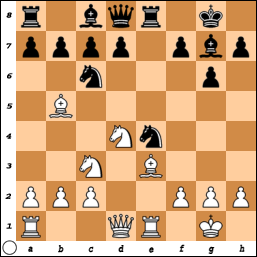
White to move (total 3 moves to win)
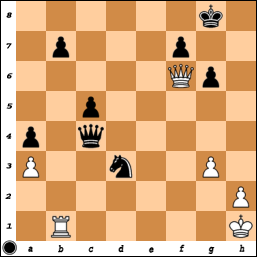
Black to move(total 4 moves to win)
The Pin

Black to move (total 3 moves to win)
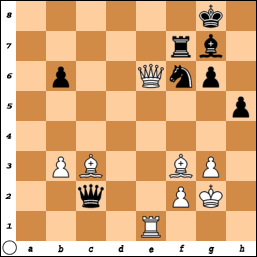
White to move (total 3 moves to win)
The Discovery

Whtie to move (total 7 moves to win)
The Skewer
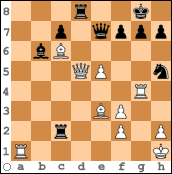
Whte to move (total 3 moves to win)
Saturday, June 27, 2009
Combinations , The Heart Of Chess
“Combinations have always been the most intriguing aspect of Chess.
The masters look for them, the public applauds them, the critics
praise them. It is because combinations are possible that Chess
is more than a lifeless mathematical exercise. They are the
poetry of the game; they are to Chess what melody is to
music. They represent the triumph of mind over matter”
(Reuben Fine)
I am posting five famous combinations from former world chess champions and famous players to show the beauty of combination in chess.
The first diagram will show the staring postion with the names of the players and the combination will be played out the Chess Flash diagram directly below it.
Steinitz vs Von Bardeleben Hastings 1895
White to play and mate in fourteen moves !
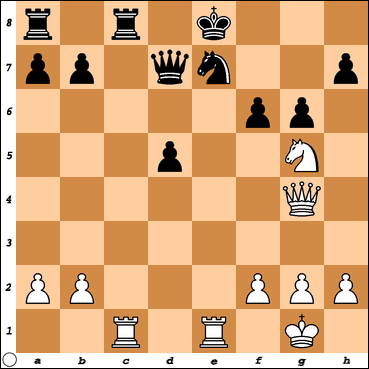
Solution To Combination
stein.pgn
Ed Lasker vs George Thomas London 1912
Whte to mate in eight moves !
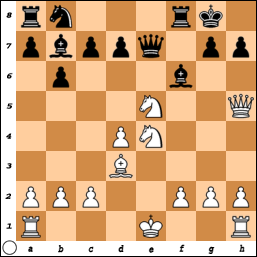
Solution To Combination
edllask.pgn
Adams vs Torre New Orleans 1920
White traps Black's Queen in six moves !
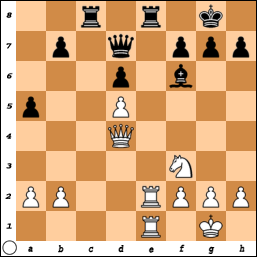
Solution To Combination
torre.pgn
Larsen vs Spassky Belgrade 1970
Black mates in four movee !
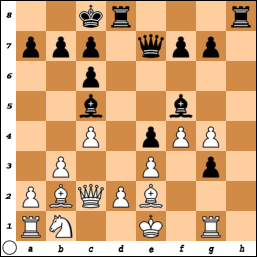
Solution To Combination
spasky.pgn
Lasker vs Bauer Amsterdam 1889
Famous Lasker Combination
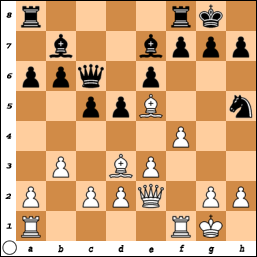
Solution To Combination
lask.pgn
Link to You Tube Video on Lasker's Sacrifice
The masters look for them, the public applauds them, the critics
praise them. It is because combinations are possible that Chess
is more than a lifeless mathematical exercise. They are the
poetry of the game; they are to Chess what melody is to
music. They represent the triumph of mind over matter”
(Reuben Fine)
I am posting five famous combinations from former world chess champions and famous players to show the beauty of combination in chess.
The first diagram will show the staring postion with the names of the players and the combination will be played out the Chess Flash diagram directly below it.
Steinitz vs Von Bardeleben Hastings 1895
White to play and mate in fourteen moves !

Solution To Combination
stein.pgn
Ed Lasker vs George Thomas London 1912
Whte to mate in eight moves !

Solution To Combination
edllask.pgn
Adams vs Torre New Orleans 1920
White traps Black's Queen in six moves !

Solution To Combination
torre.pgn
Larsen vs Spassky Belgrade 1970
Black mates in four movee !

Solution To Combination
spasky.pgn
Lasker vs Bauer Amsterdam 1889
Famous Lasker Combination

Solution To Combination
lask.pgn
Link to You Tube Video on Lasker's Sacrifice
Friday, June 26, 2009
Hoist With His Own Petard
He wrote the book on this opening. « Fearless Chess
Hamlet:
There's letters seal'd, and my two schoolfellows,
Whom I will trust as I will adders fang'd—
They bear the mandate, they must sweep my way
And marshal me to knavery. Let it work;
For 'tis the sport to have the enginer
Hoist with his own petard, an't shall go hard
But I will delve one yard below their mines
And blow them at the moon.
Here is game in Chess Flash format that can be find at the link above to the new wave blog " Fearless Chess" I call it new wave because of the clear and lucid style the blog is written along with his amateur games in Chess Flash format complete with analysis in his own words.
This blog and game was pointed out to me by Atomic Patzer at a local chess quad event in New Jersey in June 2009. Atomic mentioned that the amateur player upset a well known New Jersey master , which was posted on his blog "Fearless Chess". The NM played his favorite opening as black and unfortunately for him, he lost in an upset.
Note: Here is NJ National Master's chess blog post on this upset....diamondback
What interesting about this upset, is the NJ Master wrote the book on the opening , which is the Philidor CounterGambit he played as black against the amateur player.
There is some light analysis in the game below by Fritz 8.
Note: just click on analysis in chess flash scoresheet moves below and the variation will highlight in red and you will be able to play out the variations
Note: Corrected Game Added On Saturday June 27, 2009 Per Comments
Made By Bruce Till.... Name corrected and scoresheet corrected
tillwest_0.pgn
Hamlet:
There's letters seal'd, and my two schoolfellows,
Whom I will trust as I will adders fang'd—
They bear the mandate, they must sweep my way
And marshal me to knavery. Let it work;
For 'tis the sport to have the enginer
Hoist with his own petard, an't shall go hard
But I will delve one yard below their mines
And blow them at the moon.
Here is game in Chess Flash format that can be find at the link above to the new wave blog " Fearless Chess" I call it new wave because of the clear and lucid style the blog is written along with his amateur games in Chess Flash format complete with analysis in his own words.
This blog and game was pointed out to me by Atomic Patzer at a local chess quad event in New Jersey in June 2009. Atomic mentioned that the amateur player upset a well known New Jersey master , which was posted on his blog "Fearless Chess". The NM played his favorite opening as black and unfortunately for him, he lost in an upset.
Note: Here is NJ National Master's chess blog post on this upset....diamondback
What interesting about this upset, is the NJ Master wrote the book on the opening , which is the Philidor CounterGambit he played as black against the amateur player.
There is some light analysis in the game below by Fritz 8.
Note: just click on analysis in chess flash scoresheet moves below and the variation will highlight in red and you will be able to play out the variations
Note: Corrected Game Added On Saturday June 27, 2009 Per Comments
Made By Bruce Till.... Name corrected and scoresheet corrected
tillwest_0.pgn
Tuesday, June 23, 2009
Steinitz Blindfold Simul at Dundee 1867

When you think of international chess it is unlikely that Scotland springs to mind. Steinitz, the future first World Champion, participated in an international tournament in Dundee September 1867.
In September 1867, Gustav Neumann won the Dundee, Scotland International. 2nd place went to Steinitz
Also at Dundee, Scotland 1867 Chess Congress, future world champion William Steinitz played a blindfold simul with six opponents. His result was 3 0 3, Three wins and three draws and no losses.
On July 11 thru July 19 ,2009 the 116th Scottish Championship (International Tournement) will be held in Dundee, Scotland.
Below are the three wins of Steinitz in the blindfold simul held at the Dundee, Scotland during the Dundee chess congress of September1867.
Steinitz_-Baxler2_.pgn
Steinitz-Lindsay.pgn
William_Steinitz-Scott.pgn
Monday, June 22, 2009
Steve Stoyko Chess Training Method Revisited
Photo of Steve Stoyko
circa May 2005

I bringing this info in the forefront of this chess blog post about Steve Stoyko's Training Method , that was placed at the tail end of my last blog post, because it will help the amateur chess player grow stronger in his analysis of the middlegame.
The reason for this is to put a spotlight on the middle game analysis and how to approach this form of evaluation and visualization originated by
Steve Stoyko.
First off , let me credit where credit is due. Publication of Steve Stoyko's training method first cropped up in Dan Heisman's Novice Nook column, which by the way is not just for chess novices but for all tournement chess players under the rating of Expert.
Dan's Novice Nook column shows up monthly in the Chess Cafe , an excellent chess page with all kinds of chess columnists.
The full Novice Nook column where Steve Stoyko's Training Method is found is called.
Chess Exercises" aka "you can't play what you don't see "
The part of Dan Heisman's column where Steve Stoyko's Training Method is mentioned is towards the end of that Novice Nook column by Dan Heisman. The excerpted part of Dan's column is listed below entitled " Advanced Exercises, Stoyko Exercise.
Advanced Exercises:
A1. Stoyko Exercise
FM Steve Stoyko suggested to me this very helpful exercise. First the reader
should find a rich middlegame position. You can find them in many Kasparov,
Shirov, or Speelman games, or in the books The Magic of Tactics, Genius in
Chess, or How to Think in Chess. Take out a couple sheets of paper and a pen or
pencil.
The idea is to write everything you can possibly visualize from the position, like
you were playing the game without a clock and you had to see and record
everything before you move.
Write down every line that you look at (no matter
how bad!), along with that line's evaluation. This should fill up several sheets of
paper and take 45 minutes up to 2+ hours! If you chose a sufficiently complex
positions dozens of variations should be considered. Consider lines to as much
depth as you think is significant.
You can show your judgment of the evaluation (who stands better and by how
much – you don’t always have to say why) with any number of methods:
l A) Traditional: =, ±, ¥, …
l B) Computer - In pawns; negative means Black is better: +0.3, -1.2, …
l C) English: White is a little better, Black has compensation for his lost
pawn, etc.
When you are done, take your analysis to a good instructor, player, or software
program. Look at each line to see how well you visualized the position (any
retained images, illegal moves, etc.?), and also compare your logic (was that move
really forced?) and your evaluation.
In general the Stoyko exercise, if done properly, should help you practice and
evaluate the following skills:
l A) Analysis
l B) Visualization
l C) Evaluation
file:///C|/cafe/heisman/heisman.htm (5 of 8) [09/14/2003 2:35:12 PM]
Novice Nook
Steve claimed that each time he did this exercise he gained about 100 rating
points!
Someone asked me the following question about the evaluation aspect of the
Stoyko exercise:
"I don't understand your point: 'The key is the amateur's evaluation of every line...
you will have your instructor (or Fritz or whatever) compare your evaluation of
every line, resulting in a really good evaluation test.' How is it a 'really good
evaluation test' to analyze a single position from a Kasparov or Shirov type game
for an hour or so?
"I can see how it's a good calculation/visualization exercise - totally agreed. I've
done it in the past for this benefit and I'd do it again. But I'm just not understanding
the evaluation benefit?!"
Answer: Your question is very good (If you misunderstand that purpose of the
exercise, that would help explain my observation as to why so many players are
missing out on using this valuable resource!).
Most players are very poor at even-material evaluation. Therefore they make bad
moves because, assuming they evaluate potential outcomes of various candidate
moves, they choose a move that is not best because they erroneously think the
resultant position(s) from their chosen move are better.
The second (non-analysis) aspect of the Stoyko exercise is to evaluate every line
that you examine in the tree - that could be dozens or even possibly hundreds of
lines for one position since the Stoyko position has unlimited time. By comparing
your evaluations of these hundreds of lines with your instructors' evaluation, you
learn to improve one of the most critical skills you have - what is good and what is
bad and why and how much. It also helps you identify the all-too-common
quiescence errors where weak players stop their line too soon and therefore misevaluate because they did not look to see what might happen with further checks,
captures, and threats.
This capability is so important and its failure so critical that you would think
everyone would want to work on it, especially since the amount of work is an hour
or two, plus additional time for going over it with someone (or even at worst via
computer evaluation).
circa May 2005

I bringing this info in the forefront of this chess blog post about Steve Stoyko's Training Method , that was placed at the tail end of my last blog post, because it will help the amateur chess player grow stronger in his analysis of the middlegame.
The reason for this is to put a spotlight on the middle game analysis and how to approach this form of evaluation and visualization originated by
Steve Stoyko.
First off , let me credit where credit is due. Publication of Steve Stoyko's training method first cropped up in Dan Heisman's Novice Nook column, which by the way is not just for chess novices but for all tournement chess players under the rating of Expert.
Dan's Novice Nook column shows up monthly in the Chess Cafe , an excellent chess page with all kinds of chess columnists.
The full Novice Nook column where Steve Stoyko's Training Method is found is called.
Chess Exercises" aka "you can't play what you don't see "
The part of Dan Heisman's column where Steve Stoyko's Training Method is mentioned is towards the end of that Novice Nook column by Dan Heisman. The excerpted part of Dan's column is listed below entitled " Advanced Exercises, Stoyko Exercise.
Advanced Exercises:
A1. Stoyko Exercise
FM Steve Stoyko suggested to me this very helpful exercise. First the reader
should find a rich middlegame position. You can find them in many Kasparov,
Shirov, or Speelman games, or in the books The Magic of Tactics, Genius in
Chess, or How to Think in Chess. Take out a couple sheets of paper and a pen or
pencil.
The idea is to write everything you can possibly visualize from the position, like
you were playing the game without a clock and you had to see and record
everything before you move.
Write down every line that you look at (no matter
how bad!), along with that line's evaluation. This should fill up several sheets of
paper and take 45 minutes up to 2+ hours! If you chose a sufficiently complex
positions dozens of variations should be considered. Consider lines to as much
depth as you think is significant.
You can show your judgment of the evaluation (who stands better and by how
much – you don’t always have to say why) with any number of methods:
l A) Traditional: =, ±, ¥, …
l B) Computer - In pawns; negative means Black is better: +0.3, -1.2, …
l C) English: White is a little better, Black has compensation for his lost
pawn, etc.
When you are done, take your analysis to a good instructor, player, or software
program. Look at each line to see how well you visualized the position (any
retained images, illegal moves, etc.?), and also compare your logic (was that move
really forced?) and your evaluation.
In general the Stoyko exercise, if done properly, should help you practice and
evaluate the following skills:
l A) Analysis
l B) Visualization
l C) Evaluation
file:///C|/cafe/heisman/heisman.htm (5 of 8) [09/14/2003 2:35:12 PM]
Novice Nook
Steve claimed that each time he did this exercise he gained about 100 rating
points!
Someone asked me the following question about the evaluation aspect of the
Stoyko exercise:
"I don't understand your point: 'The key is the amateur's evaluation of every line...
you will have your instructor (or Fritz or whatever) compare your evaluation of
every line, resulting in a really good evaluation test.' How is it a 'really good
evaluation test' to analyze a single position from a Kasparov or Shirov type game
for an hour or so?
"I can see how it's a good calculation/visualization exercise - totally agreed. I've
done it in the past for this benefit and I'd do it again. But I'm just not understanding
the evaluation benefit?!"
Answer: Your question is very good (If you misunderstand that purpose of the
exercise, that would help explain my observation as to why so many players are
missing out on using this valuable resource!).
Most players are very poor at even-material evaluation. Therefore they make bad
moves because, assuming they evaluate potential outcomes of various candidate
moves, they choose a move that is not best because they erroneously think the
resultant position(s) from their chosen move are better.
The second (non-analysis) aspect of the Stoyko exercise is to evaluate every line
that you examine in the tree - that could be dozens or even possibly hundreds of
lines for one position since the Stoyko position has unlimited time. By comparing
your evaluations of these hundreds of lines with your instructors' evaluation, you
learn to improve one of the most critical skills you have - what is good and what is
bad and why and how much. It also helps you identify the all-too-common
quiescence errors where weak players stop their line too soon and therefore misevaluate because they did not look to see what might happen with further checks,
captures, and threats.
This capability is so important and its failure so critical that you would think
everyone would want to work on it, especially since the amount of work is an hour
or two, plus additional time for going over it with someone (or even at worst via
computer evaluation).
Saturday, June 20, 2009
More Coffee House Chess At Hamilton Chess Quads June 20, 2009
The two games posted on this blog post are: Diamondback vs John Lekocevich, John is an upcoming Class D player , who is stronger than his game posted here.
The second game is of Dion Callaghan, who plays black, using the Dutch Defense.
As always , the games are playable using Chess Flash.

Today on Saturday, I played at Hamilton Chess Quads in Groveville, New Jersey after I told myself and others several weeks ago , that I was hanging up my chess board and use it for practicing throwing darts.
In order to be "Chess Free" one has to undergo massive deprogrmaming , since all chess players, I know, Chess is part of their personality, and for those, including myself , to leave chess behind would cause psyschological withdrawal symptons, since Chess is not a physcical addiction but a mental one.
After you play over my last round game, one has to agree, that I am not using my complete thought process in the game itself.
I have to train myself in using a complete thought process by using the "Steve Stoyko Training Method is chess thought processing.
More on the "Steve Stoyko Training Method " listed after these two Chess Flash Games.
Pics from 6/20/2009 Hamilton Chess Quads in Groveville, New Jersey can be found at this link :
Jim West On Chess.
The first Chess Flash Game is Diamondback vs John L. Reti Opening.
This game is being placed in my "Hall Of Shame" as a reminder that I have
to Think before touching a chess piece. By that , I mean total board vision and going thru candidates moves per Dan Heisman , chess teacher in Philadelphia,PA .
HmlJn09.pgn
The next game below features two knight versus lone rook endgame played out by Chessmaster 10th edition, with black to move based on the game above, diamondback vs. John L.
diamondbackvsJohnl.PGN
The second Chess Flash game is between Dion Callaghan and Ben B. Dion is a strong Class D player. Dutch Defense
Hml2Jn.pgn
.blogspot.com/">
Note: This third game was added to this orignal post on Sunday , June 21, 2009, the date of the orignal post was yesterday , Saturday , June 20, 2009.....diamondback
The third game below is between myself and Scott R Andreacchi, Scott is a part time student of Dan Heisman, NM who teaches chess and Scott utilizes the Steve Stoyko Training Method for self study.
Anaylysis is by Fritz 8 and Fritz is showing somewhat drawish based on that anaylsis.
I took black's knight on F6 knowing that Black must take back with his G pawn , the reason for my taking on the f6 square was to expose Black's King , but I could not muster a king side attack.
Rd2HmltQds.pgn
A very nice fellow amateur chess player Scot A mentioned after we did our post mortem on our game today ,about a training method endorsed by Steve Stoyko, which was recommended by Dan Heisman to his student Scott A. Some more detail about "Steve Stoyko training method is listed below: I believe Atomic Patzer is using something similar in his thought process training methods.
Advanced Exercises:
A1. Stoyko Exercise
FM Steve Stoyko suggested to me this very helpful exercise. First the reader
should find a rich middlegame position. You can find them in many Kasparov,
Shirov, or Speelman games, or in the books The Magic of Tactics, Genius in
Chess, or How to Think in Chess. Take out a couple sheets of paper and a pen or
pencil.
The idea is to write everything you can possibly visualize from the position, like
you were playing the game without a clock and you had to see and record
everything before you move.
Write down every line that you look at (no matter
how bad!), along with that line's evaluation. This should fill up several sheets of
paper and take 45 minutes up to 2+ hours! If you chose a sufficiently complex
positions dozens of variations should be considered. Consider lines to as much
depth as you think is significant.
You can show your judgment of the evaluation (who stands better and by how
much – you don’t always have to say why) with any number of methods:
l A) Traditional: =, ±, ¥, …
l B) Computer - In pawns; negative means Black is better: +0.3, -1.2, …
l C) English: White is a little better, Black has compensation for his lost
pawn, etc.
When you are done, take your analysis to a good instructor, player, or software
program. Look at each line to see how well you visualized the position (any
retained images, illegal moves, etc.?), and also compare your logic (was that move
really forced?) and your evaluation.
In general the Stoyko exercise, if done properly, should help you practice and
evaluate the following skills:
l A) Analysis
l B) Visualization
l C) Evaluation
file:///C|/cafe/heisman/heisman.htm (5 of 8) [09/14/2003 2:35:12 PM]
Novice Nook
Steve claimed that each time he did this exercise he gained about 100 rating
points!
Someone asked me the following question about the evaluation aspect of the
Stoyko exercise:
"I don't understand your point: 'The key is the amateur's evaluation of every line...
you will have your instructor (or Fritz or whatever) compare your evaluation of
every line, resulting in a really good evaluation test.' How is it a 'really good
evaluation test' to analyze a single position from a Kasparov or Shirov type game
for an hour or so?
"I can see how it's a good calculation/visualization exercise - totally agreed. I've
done it in the past for this benefit and I'd do it again. But I'm just not understanding
the evaluation benefit?!"
Answer: Your question is very good (If you misunderstand that purpose of the
exercise, that would help explain my observation as to why so many players are
missing out on using this valuable resource!).
Most players are very poor at even-material evaluation. Therefore they make bad
moves because, assuming they evaluate potential outcomes of various candidate
moves, they choose a move that is not best because they erroneously think the
resultant position(s) from their chosen move are better.
The second (non-analysis) aspect of the Stoyko exercise is to evaluate every line
that you examine in the tree - that could be dozens or even possibly hundreds of
lines for one position since the Stoyko position has unlimited time. By comparing
your evaluations of these hundreds of lines with your instructors' evaluation, you
learn to improve one of the most critical skills you have - what is good and what is
bad and why and how much. It also helps you identify the all-too-common
quiescence errors where weak players stop their line too soon and therefore misevaluate because they did not look to see what might happen with further checks,
captures, and threats.
This capability is so important and its failure so critical that you would think
everyone would want to work on it, especially since the amount of work is an hour
or two, plus additional time for going over it with someone (or even at worst via
computer evaluation).
A2. PV
The second game is of Dion Callaghan, who plays black, using the Dutch Defense.
As always , the games are playable using Chess Flash.

Today on Saturday, I played at Hamilton Chess Quads in Groveville, New Jersey after I told myself and others several weeks ago , that I was hanging up my chess board and use it for practicing throwing darts.
In order to be "Chess Free" one has to undergo massive deprogrmaming , since all chess players, I know, Chess is part of their personality, and for those, including myself , to leave chess behind would cause psyschological withdrawal symptons, since Chess is not a physcical addiction but a mental one.
After you play over my last round game, one has to agree, that I am not using my complete thought process in the game itself.
I have to train myself in using a complete thought process by using the "Steve Stoyko Training Method is chess thought processing.
More on the "Steve Stoyko Training Method " listed after these two Chess Flash Games.
Pics from 6/20/2009 Hamilton Chess Quads in Groveville, New Jersey can be found at this link :
Jim West On Chess.
The first Chess Flash Game is Diamondback vs John L. Reti Opening.
This game is being placed in my "Hall Of Shame" as a reminder that I have
to Think before touching a chess piece. By that , I mean total board vision and going thru candidates moves per Dan Heisman , chess teacher in Philadelphia,PA .
HmlJn09.pgn
The next game below features two knight versus lone rook endgame played out by Chessmaster 10th edition, with black to move based on the game above, diamondback vs. John L.
diamondbackvsJohnl.PGN
The second Chess Flash game is between Dion Callaghan and Ben B. Dion is a strong Class D player. Dutch Defense
Hml2Jn.pgn
.blogspot.com/">
Note: This third game was added to this orignal post on Sunday , June 21, 2009, the date of the orignal post was yesterday , Saturday , June 20, 2009.....diamondback
The third game below is between myself and Scott R Andreacchi, Scott is a part time student of Dan Heisman, NM who teaches chess and Scott utilizes the Steve Stoyko Training Method for self study.
Anaylysis is by Fritz 8 and Fritz is showing somewhat drawish based on that anaylsis.
I took black's knight on F6 knowing that Black must take back with his G pawn , the reason for my taking on the f6 square was to expose Black's King , but I could not muster a king side attack.
Rd2HmltQds.pgn
A very nice fellow amateur chess player Scot A mentioned after we did our post mortem on our game today ,about a training method endorsed by Steve Stoyko, which was recommended by Dan Heisman to his student Scott A. Some more detail about "Steve Stoyko training method is listed below: I believe Atomic Patzer is using something similar in his thought process training methods.
Advanced Exercises:
A1. Stoyko Exercise
FM Steve Stoyko suggested to me this very helpful exercise. First the reader
should find a rich middlegame position. You can find them in many Kasparov,
Shirov, or Speelman games, or in the books The Magic of Tactics, Genius in
Chess, or How to Think in Chess. Take out a couple sheets of paper and a pen or
pencil.
The idea is to write everything you can possibly visualize from the position, like
you were playing the game without a clock and you had to see and record
everything before you move.
Write down every line that you look at (no matter
how bad!), along with that line's evaluation. This should fill up several sheets of
paper and take 45 minutes up to 2+ hours! If you chose a sufficiently complex
positions dozens of variations should be considered. Consider lines to as much
depth as you think is significant.
You can show your judgment of the evaluation (who stands better and by how
much – you don’t always have to say why) with any number of methods:
l A) Traditional: =, ±, ¥, …
l B) Computer - In pawns; negative means Black is better: +0.3, -1.2, …
l C) English: White is a little better, Black has compensation for his lost
pawn, etc.
When you are done, take your analysis to a good instructor, player, or software
program. Look at each line to see how well you visualized the position (any
retained images, illegal moves, etc.?), and also compare your logic (was that move
really forced?) and your evaluation.
In general the Stoyko exercise, if done properly, should help you practice and
evaluate the following skills:
l A) Analysis
l B) Visualization
l C) Evaluation
file:///C|/cafe/heisman/heisman.htm (5 of 8) [09/14/2003 2:35:12 PM]
Novice Nook
Steve claimed that each time he did this exercise he gained about 100 rating
points!
Someone asked me the following question about the evaluation aspect of the
Stoyko exercise:
"I don't understand your point: 'The key is the amateur's evaluation of every line...
you will have your instructor (or Fritz or whatever) compare your evaluation of
every line, resulting in a really good evaluation test.' How is it a 'really good
evaluation test' to analyze a single position from a Kasparov or Shirov type game
for an hour or so?
"I can see how it's a good calculation/visualization exercise - totally agreed. I've
done it in the past for this benefit and I'd do it again. But I'm just not understanding
the evaluation benefit?!"
Answer: Your question is very good (If you misunderstand that purpose of the
exercise, that would help explain my observation as to why so many players are
missing out on using this valuable resource!).
Most players are very poor at even-material evaluation. Therefore they make bad
moves because, assuming they evaluate potential outcomes of various candidate
moves, they choose a move that is not best because they erroneously think the
resultant position(s) from their chosen move are better.
The second (non-analysis) aspect of the Stoyko exercise is to evaluate every line
that you examine in the tree - that could be dozens or even possibly hundreds of
lines for one position since the Stoyko position has unlimited time. By comparing
your evaluations of these hundreds of lines with your instructors' evaluation, you
learn to improve one of the most critical skills you have - what is good and what is
bad and why and how much. It also helps you identify the all-too-common
quiescence errors where weak players stop their line too soon and therefore misevaluate because they did not look to see what might happen with further checks,
captures, and threats.
This capability is so important and its failure so critical that you would think
everyone would want to work on it, especially since the amount of work is an hour
or two, plus additional time for going over it with someone (or even at worst via
computer evaluation).
A2. PV
Thursday, June 18, 2009
Wednesday, June 17, 2009
A Very Different Bobby Fischer
Appearing on The Dick Cavett Show in the summer of 1971, Bobby Fischer shares his various views about chess.
One month after Bobby Fischer's death Dick Cavett wrote this piece in the New York Times titled " Was It Only A Game ? "
In this article Dick Cavett writes "Towering genius, riches, international fame and a far from normal childhood might be too heady a mix for anyone to handle. For him they proved fatal".
Robert James Fischer was born on March 9, 1943, in Chicago. By the age of 14, Bobby Fischer won the US Championship, becoming the youngest player ever to win that title. In 1958, at the age of 15, he became the youngest international grandmaster in history. He won the US Championship eight times in eight attempts, including, at the age of 20, setting a record with a perfect 11-0 score. In 1971 he set another record, when he won the quarter-final and semi-final matches for the world championship by identical scores of 6-0 against Mark Taimanov and Bent Larsen respectively. Then, when he won against Tigran Vartanovich Petrosian in the first game of the final candidate match, he had thus set a record of 20 consecutive wins (without draws) at the highest level of competition. By 1972 he achieved a FIDE rating of 2785, making him, at that time, the highest rated player in history.
In Reykjavik, 1972, Fischer became the 11th World Chess Champion by defeating the defending champion, Boris Spassky in what is often referred to as "The Match of the Century." The final score was 12½ to 8½. In 1975, FIDE refused to meet Fischer's conditions for a World Championship match with Anatoli Karpov, and Fischer consequently refused to play. FIDE therefore awarded the title of World Champion to Karpov. Fischer then vanished from the public eye for twenty years. He resurfaced in 1992 to play a match against his old rival Spassky in Yugoslavia, which he won, 10 to 5 (with 15 draws). This action violated a U.N. sanction, and Fischer evaded authorities for twelve years until July 13, 2004, when he was arrested in Japan. On March 22, 2005, he was granted Icelandic citizenship and finally freed from Japan. He died of renal failure in Iceland in 2008.
One month after Bobby Fischer's death Dick Cavett wrote this piece in the New York Times titled " Was It Only A Game ? "
In this article Dick Cavett writes "Towering genius, riches, international fame and a far from normal childhood might be too heady a mix for anyone to handle. For him they proved fatal".
Robert James Fischer was born on March 9, 1943, in Chicago. By the age of 14, Bobby Fischer won the US Championship, becoming the youngest player ever to win that title. In 1958, at the age of 15, he became the youngest international grandmaster in history. He won the US Championship eight times in eight attempts, including, at the age of 20, setting a record with a perfect 11-0 score. In 1971 he set another record, when he won the quarter-final and semi-final matches for the world championship by identical scores of 6-0 against Mark Taimanov and Bent Larsen respectively. Then, when he won against Tigran Vartanovich Petrosian in the first game of the final candidate match, he had thus set a record of 20 consecutive wins (without draws) at the highest level of competition. By 1972 he achieved a FIDE rating of 2785, making him, at that time, the highest rated player in history.
In Reykjavik, 1972, Fischer became the 11th World Chess Champion by defeating the defending champion, Boris Spassky in what is often referred to as "The Match of the Century." The final score was 12½ to 8½. In 1975, FIDE refused to meet Fischer's conditions for a World Championship match with Anatoli Karpov, and Fischer consequently refused to play. FIDE therefore awarded the title of World Champion to Karpov. Fischer then vanished from the public eye for twenty years. He resurfaced in 1992 to play a match against his old rival Spassky in Yugoslavia, which he won, 10 to 5 (with 15 draws). This action violated a U.N. sanction, and Fischer evaded authorities for twelve years until July 13, 2004, when he was arrested in Japan. On March 22, 2005, he was granted Icelandic citizenship and finally freed from Japan. He died of renal failure in Iceland in 2008.
Monday, June 15, 2009
Notable Games of William Steinitz

Steinitz vs Mongredien 1862 London
This game was awarded the brilliancy prize at the 1862 London International Tournament.
steinitz_mongredien_1862.pgn
William Steinitz vs Curt von Bardeleben Hastings 1895
A great attacking combination in the old 1860s style. After White's 22nd move, all the White pieces are en prise but Black is lost. The game won the first brilliancy prize of the tournament.
von_bardeleben_steinitz_1895.pgn
Wilhelm (later William) Steinitz (May 17, 1836 – August 12, 1900) was an AustrianPeople
The World Chess Championship is played to determine the World Champion in the board game chess. Both men and women are eligible to contest this title....
from 1886 to 1894. Some contemporaries and later writers described him as world champion since 1866, when he won a match against Adolf AnderssenAdolf Anderssen
Karl Ernst Adolf Anderssen was a Germany chess master. He is considered to have been the world leading chess player from 1851 to 1858, and from 1861 to 1866....
. Steinitz lost his title to Emanuel LaskerEmanuel Lasker
Emanuel Lasker was a Germany chess player, mathematician, and Philosophy who was World Chess Championship for 27 years. In his prime Lasker was one of the most dominant champions, and he is still generally regarded as one of the strongest players ever....
in 1894 and also lost a re-match in 1897.
Sunday, June 14, 2009
Chess Portal
Here is complete chess web page called Your Chess Net , which is a chess aggregator.
The idea behind this site is provide complete chess news provided through RSS feeds, podcasts, embedded ojects, and flash video.
This page is loadable in Eglish, French, German, and Spanish, once you load the language you want, then you register and save that page. When the main page is loaded, you get links and feeds to FIDE news, Susan Polgar's, 365chess.com and Chess.com.
On the far right hand side of the web page is a bookmarks section , which has already approximately 30 or some chess bookmarks and at the bottom you have an add bookmark button.
On the bottom right is a video panel when you can click on various You Tube videos, below is a You Tube video from the early 1990's from Saturday Night Live titled:
"The Perfect Chess Cheer" which I found on the video panel located on Your Chess Net.
The idea behind this site is provide complete chess news provided through RSS feeds, podcasts, embedded ojects, and flash video.
This page is loadable in Eglish, French, German, and Spanish, once you load the language you want, then you register and save that page. When the main page is loaded, you get links and feeds to FIDE news, Susan Polgar's, 365chess.com and Chess.com.
On the far right hand side of the web page is a bookmarks section , which has already approximately 30 or some chess bookmarks and at the bottom you have an add bookmark button.
On the bottom right is a video panel when you can click on various You Tube videos, below is a You Tube video from the early 1990's from Saturday Night Live titled:
"The Perfect Chess Cheer" which I found on the video panel located on Your Chess Net.
Thursday, June 11, 2009
The Intrepid Dragan

This game is currently in the January/March 2009 issue of Atlantic Chess News , where the link can be found on Jim West On Chess.
The game was played in the World Amateur East Team Championship in February 2009 at Parisippany, New Jersey.
Dragan_Milovanovic-Jon_Jacobs.pgn
Dragan ( born in Bosnia, previously known as Yugoslavia ) was new to the HCC in November, 1999. He entered his first tourney (Game 15 Championship) and came out 4-0 in First Place. Since that time, we have not seen this Club Champion lose more than 2 or 3 games
Continuing his excellence in Club Competitions, Dragan became a Co-Champion of HCC along with Vlad Vainberg in the Millenium year, as they both played to identical records in our Annual Tournment. But in 2001 Dragan won the sole Championship title, and repeated in 2002 thru 2009 inclusive, nine consecutive years total, also in the year 2000, he was co-champion. He is our first Club Champion to win in nine consecutive years. Pete Peterson's Five Championships was tied in 2004 by Dragan. Dragan's current USCF rating is 2221. His brother who lives in Dallas Texas, Rade Milovanovic is even a stronger player ... perhaps he'll visit us sometime.
In addition to being a very strong Chess player, Dragan is perhaps the softest spoken high rated player I've ever known ... a true gentleman
Wednesday, June 10, 2009
Reti Opening

Richard Reti
The Réti Opening is a hypermodern chess opening characterized by the opening move 1.Nf3 to prevent 1...e5, with the intention of following up, against the "classically recommended" response 1...d5, with 2.c4, coupled with a kingside fianchetto to create pressure on the light squares in the center. One idea behind the opening is to either bring the d5 pawn under attack from the flanks, or entice it to advance to d4 and undermine it later. Because the single opening move 1.Nf3 is rife with transpositional possibilities, it is incorrect to infer that any chess game opening with that move is an example of the Réti Opening. For example, 1.Nf3 d5 2.c4 e6 3.d4 Nf6 4.Nc3 is the Queen's Gambit Declined. The Réti should not be thought of as a single opening sequence, and certainly not a single opening move, but as an opening complex with many variations sharing common themes. It is named after Richard Réti, an untitled Grandmaster from Czechoslovakia who most famously used it to defeat José Raúl Capablanca, the reigning World Chess Champion, in a game in the 1924 New York tournament. The Réti Opening was introduced into master play in the early part of 1923, according to Réti.[1] In the Encyclopaedia of Chess Openings (ECO) Réti Opening is classified A04-A09. Hans Kmoch called the system of attack employed by Réti in the game Réti-Rubinstein, Carlsbad, 1923 "the Réti Opening" or "the Réti System." Savielly Tartakower had earlier named this opening "The Opening of the Future."
Scoresheet of Réti-Capablanca gameAccording to ChessBase, out of the twenty possible opening moves, 1. Nf3 ranks third in popularity. It develops the knight to a good square and prepares for quick castling and prevents Black's occupation of the center by 1...e5. White maintains flexibility by not committing to a particular central pawn structure, while waiting to see what Black will do. Two slight drawbacks to the move are that it blocks the f-pawn, and forgoes the option of playing Nge2, ruling out the possibility, for example, of playing the Sämisch system against the King's Indian
Reti Opening Wikipedia
Monday, June 8, 2009
Alekhine's Defense Chess Opening

Alexander Alekhine circa 1925
Alekhine's Defence is a chess opening beginning with the moves
1. e4 Nf6
It is named after Alexander Alekhine, who introduced it in the 1921 Budapest tournament in games against Endre Steiner[1] and Fritz Sämisch.[2] Four years later, the editors of the Fourth Edition of Modern Chess Openings (MCO-4) wrote, "Nothing is more indicative of the iconoclastic conceptions of the 'hypermodern school' than the bizarre defence introduced by Alekhine ... . Although opposing to all tenets of the classical school, Black allows his King's Knight to be driven about the board in the early stages of the game, in the expectation of provoking a weakness in White's centre pawns."[3] White's imposing mass of pawns in the centre often includes pawns on c4, d4, e5, and f4. Grandmaster Nick de Firmian observes of Alekhine's in MCO-15 (2008), "The game immediately loses any sense of symmetry or balance, which makes the opening a good choice for aggressive fighting players."[4]
In addition to Alekhine, another early exponent of the defence was Ernst Grünfeld. Its popularity waxes and wanes; currently it is not very common. De Firmian observes, "The fashion could quickly change if some champion of the opening takes up the cause, as the results Black has obtained in practice are good."[4] The opening's current highest-rated proponent is Grandmaster Vassily Ivanchuk, although Grandmaster Lev Alburt has done much to promote it. De Firmian writes, "Currently Grandmasters Shabalov and Minasian use the opening with regularity, while Aronian, Adams, and Nakamura will use it on occasion. In the past, great players such as Fischer and Korchnoi included the defense in their repertoire, leading to its respectable reputation
Sunday, June 7, 2009
Ruy Lopez Classical Opening
This chess lesson titled " Chess Lessons : Ruy Lopez Opening : Classical Defence, Chess Video by Mr.Fisk. The game is between Emmanuel Lasker and Wilhelm Steinitz , the year is 1896.
This is one of the better chess videos on the Ruy Lopez posted on You Tube....diamondback
The game after the Chess Video is in Chess Flash format avaiblabe for replay and download.
This game explores the Ruy Lopez Classical Defence opening. The video includes a match between Emanuel Lasker and Wilhelm Steinitz in the Chess World Championship rematch in 1896. - youtube
value="http://www.youtube.com/v/M1qgxLYZGKA&hl=en&fs=1&rel=0">
via videosift.com
LaskervsSteinitz.pgn
This is one of the better chess videos on the Ruy Lopez posted on You Tube....diamondback
The game after the Chess Video is in Chess Flash format avaiblabe for replay and download.
This game explores the Ruy Lopez Classical Defence opening. The video includes a match between Emanuel Lasker and Wilhelm Steinitz in the Chess World Championship rematch in 1896. - youtube
value="http://www.youtube.com/v/M1qgxLYZGKA&hl=en&fs=1&rel=0">
via videosift.com
LaskervsSteinitz.pgn
Subscribe to:
Posts (Atom)